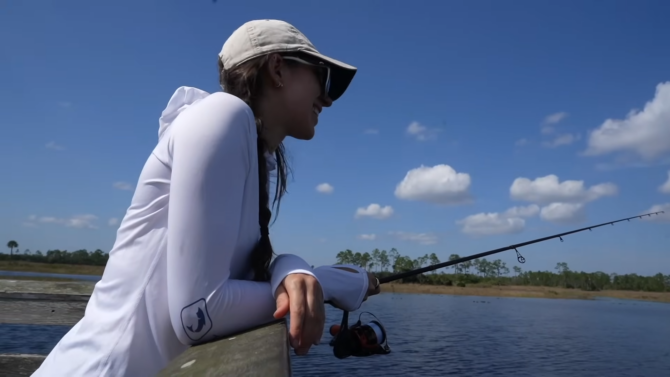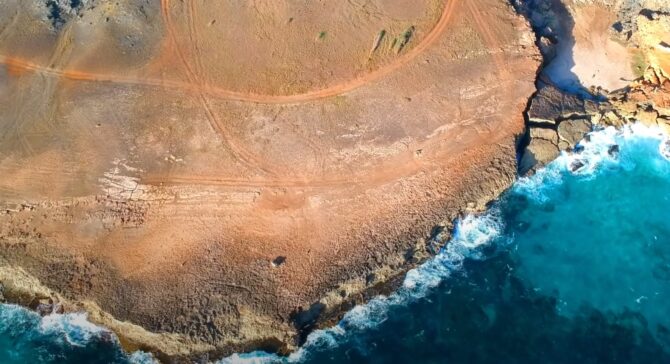The deep sea, a vast and mysterious expanse, is a world unlike any other. Shrouded in eternal darkness, subjected to immense pressure, and chilled by bone-numbing temperatures, it’s a realm that seems almost alien to us.
Yet, within this seemingly inhospitable environment, life thrives in the most unexpected ways. The creatures that call the deep sea home are not just survivors; they are marvels of evolution, having developed astonishing adaptations to navigate the challenges of their environment.
From bioluminescent lures to incredible camouflage techniques, these denizens of the abyss showcase nature’s ability to innovate and adapt. As we delve deeper into this enigmatic world, we’ll encounter 27 of the most spine-chilling and awe-inspiring creatures that lurk in the depths of fear.
Join me on this exhilarating journey, as we uncover the hidden wonders and mysteries of our planet’s final frontier.
27. Frilled Shark
Often referred to as a “living fossil,” the frilled shark is a species that has retained some of the features of its primitive ancestors.
Interesting Fact:
The frilled shark is an example of a “living fossil,” an extant animal whose appearance has not evolved much through the millennia. This shark primarily preys on squid and has even been known to feed on other sharks.
26. Hagfish
Known for their repulsive feeding habits, hagfish consume the decaying carcasses of other sea creatures by burrowing into them with tooth-like structures.
Interesting Fact:
There are estimated to be 76 species of hagfish, and some live as deep as 5,500 feet below the water’s surface. They are also known as slime eels because of the goop their bodies produce to ward off predators.
25. Atlantic Wolffish
A predatory species characterized by a mouth full of sharp, canine-like teeth, the Atlantic wolffish feeds on hard-bodied or spiny invertebrates like sea urchins and large marine snails.
Interesting Fact:
The Atlantic wolffish can grow up to five feet long and is found in the North Atlantic and Arctic Oceans. Despite its menacing appearance, it is not aggressive towards humans unless provoked.
24. Goblin Shark
Identifiable by the shape of their elongated and flattened snouts, goblin sharks are a rare, bottom-dwelling species with 50 teeth in their mouths.
Interesting Fact:
Female goblin sharks are larger in adulthood than the males of the species. Females can be a maximum of 11 inches long, while males grow to be an average length of 8.66 inches.
23. Japanese Spider Crab
Native to the Pacific Ocean, the Japanese spider crab is one of the largest known arthropods, a group of invertebrate animals that also includes lobsters, spiders, and insects.
Interesting Fact:
The Japanese spider crab can grow up to 15 inches wide and weigh up to 44 pounds.
22. Vampire Squid
Despite its sinister name, the vampire squid is neither a squid nor an octopus. It is found in the inky depths of the mesopelagic zone, about 3,300 feet below the ocean’s surface.
Interesting Fact:
The vampire squid’s scientific name, Vampyroteuthis infernalis, means “vampire squid from hell.” However, it doesn’t feed on blood but subsists on “marine snow,” decaying organic material that falls to the ocean floor.
21. Anglerfish
The anglerfish is best known for the bioluminescent growth on its head, which it uses to lure its prey to its death.
Interesting Fact:
In many species of anglerfish, like the humpback anglerfish, the females grow to sizes much larger than their male counterparts. Males exist primarily for mating and, once they find a female, they bite into her flesh and become a parasite, feeding off her blood.
20. Deep Sea Blob Sculpin
This fish bears a striking resemblance to the alien from the horror movie, “The Blob.”
Interesting Fact:
These fish are usually found at depths of up to 2,800 meters along the U.S. West coast. They often get caught in nets that indiscriminately trawl the seafloor for commercially important species like crabs.
19. Sea Pigs
Despite their name, sea pigs are not pigs at all. They are a type of sea cucumber found in very deep waters throughout the world’s oceans.
Interesting Fact:
Researchers have observed sea pigs in large groups, sometimes numbering in the hundreds, crawling along the sea floor.
18. The Proboscis Worm
This worm scavenges for food on the seafloor and grows to lengths of up to two meters.
Interesting Fact:
The proboscis worm is not picky about its diet. It will eat pretty much anything it comes across and has few—if any—predators.
17. Zombie Worms
These worms have a unique habitat: they live in the bones of dead whales.
Interesting Fact:
Zombie worms have no mouth, anus, or gut. They survive by secreting an acid that breaks up the whalebone. With the help of bacteria that digest whale fat, these worms are able to absorb nutrients.
16. Stonefish
Camouflaged to look like a rock on the floor of a coral reef, the stonefish is the most venomous fish in the world.
Interesting Fact:
The stonefish has 13 spines along its back that release venom, which can be fatal to humans if not treated within a few hours.
15. Sloane’s Viperfish
At less than a foot long, this fish might seem harmless, but its teeth tell a different story.
Interesting Fact:
The fang-like teeth of the Sloane’s viperfish are more than half the size of its head. This allows the fish to impale its prey by swimming at its headfirst, mouth wide open.
14. Red Octopus
This eerily beautiful octopus is found in the deep Atlantic waters off the U.S. Coast.
Interesting Fact:
Rows of glowing bioluminescent suckers trail down its eight arms. Scientists believe these glow-in-the-dark suckers may be used to attract planktonic prey, similar to how insects are drawn to light.
13. Giant Isopods
These creatures look like oversized woodlice and are known to scavenge the dead carcasses of fish, squid, and whales.
Interesting Fact:
Giant isopods live in the deep sea and have been observed to go for long periods without food, sometimes even up to five years.
12. The Goblin Shark
This shark is reminiscent of a prehistoric dinosaur with its long snout, small eyes, and jagged teeth.
Interesting Fact:
The goblin shark’s extended snout helps it detect food on the ocean floor. Its jaw can extend and retract, allowing it to snatch prey with precision.
11. The Sloane’s Viperfish
Despite being less than a foot long, Sloane’s viperfish has teeth that are a force to be reckoned with.
Interesting Fact:
The fang-like teeth of this fish are more than half the size of its head, allowing it to impale its prey with ease.
10. The Barreleye Fish
With a transparent head and tubular eyes, the Barreleye fish looks like something straight out of a sci-fi movie.
Interesting Fact:
The fish’s unique transparent head allows it to look upwards through its skull, helping it spot potential prey or predators from below.
9. The Sarcastic Fringehead
Despite its humorous name, there’s nothing funny about this aggressive fish when it’s defending its territory.
Interesting Fact:
When two fringeheads have a territorial battle, they wrestle by pressing their distended mouths against each other, as if they were kissing. This allows them to determine which fish is the larger and therefore the one that wins the territory.
8. The Black Dragonfish
This bioluminescent predator has a long, slender body and a set of sharp teeth.
Interesting Fact:
The female Black Dragonfish can extend its jaw and stomach to an enormous size, allowing it to eat prey up to half its body length.
7. The Deep-sea Hatchet Fish
Named for its thin, flat body, the hatchet fish has large, tubular eyes pointing upwards to detect the silhouettes of available prey.
Interesting Fact:
The hatchet fish uses bioluminescent photophores on its body to produce light, which helps it camouflage from predators below by matching the ambient light from above.
6. The Fangtooth Fish
With the largest teeth of any fish in the ocean (proportional to body size), the Fangtooth has an undeniably menacing appearance.
Interesting Fact:
Despite its fearsome look, the Fangtooth is quite small and harmless to humans, rarely growing longer than six inches.
5. The Pacific Viperfish
With needle-like teeth and hinged lower jaws, the Pacific Viperfish is one of the most striking deep-sea predators.
Interesting Fact:
During the day, the Viperfish stays in deep waters but comes closer to the surface at night to feed, using its bioluminescent belly to attract prey.
4. The Deep-sea Anglerfish
Known for the bioluminescent lure that hangs in front of its mouth, the Anglerfish is one of the deep sea’s most iconic creatures.
Interesting Fact:
The male Anglerfish is much smaller than the female and, once it finds a mate, it bites into her belly and fuses to her, living the rest of its life as a parasite.
3. The Giant Squid
A legendary creature, the Giant Squid was once believed to be a myth. It can grow up to 43 feet in length.
Interesting Fact:
The Giant Squid has the largest eyes in the animal kingdom, measuring up to 10 inches in diameter.
2. The Colossal Squid
Even larger than the Giant Squid, the Colossal Squid remains one of the ocean’s most elusive creatures.
Interesting Fact:
The Colossal Squid’s tentacles are equipped with sharp hooks, some of which can rotate, making it a formidable predator.
1. The Cthulhu Larva
Named after H.P. Lovecraft’s legendary sea monster, this deep-sea polychaete worm has tentacles sprouting from its head.
Interesting Fact:
Despite its terrifying appearance, the Cthulhu Larva is quite small, usually measuring less than an inch in length.
FAQ
Why are deep-sea creatures so different?
The extreme conditions of the deep sea, such as perpetual darkness, immense pressure, and cold temperatures, have led to unique evolutionary adaptations in its inhabitants. These adaptations, which can include bioluminescence, elongated limbs, and specialized feeding mechanisms, help these creatures survive in their challenging environment.
How do deep-sea creatures survive in high pressure?
Deep-sea organisms have evolved bodies that are adapted to the high-pressure environment. Their cellular structures and body compositions are such that they can withstand crushing pressures without being harmed.
Why do deep-sea creatures have bioluminescence?
Bioluminescence serves multiple purposes in the deep sea. It can be used to attract prey, communicate with potential mates, or deter predators.
In the pitch-black depths, producing light can be a crucial survival tool.
How do researchers study deep-sea creatures?
Researchers use specialized equipment like remotely operated vehicles (ROVs) and deep-sea submersibles to observe and sometimes collect specimens. These tools are designed to operate in high-pressure environments and can capture images and data without causing significant disturbance to marine life.
Are there still many undiscovered deep-sea creatures?
Absolutely! The deep sea is one of the least explored regions on Earth.
Scientists estimate that there are potentially millions of undiscovered species in the ocean’s depths, each with its own unique adaptations and roles within the ecosystem.
How do deep-sea creatures find food?
Many deep-sea creatures have evolved specialized hunting and feeding strategies. Some use bioluminescent lures to attract prey, while others scavenge the remains of dead organisms that sink from the surface.
Additionally, some deep-sea organisms can go for extended periods without food, conserving energy until their next meal opportunity.
Bottom Line
The vastness of our oceans conceals a world that remains largely uncharted, a realm where the unimaginable becomes reality. From the “living fossil” Frilled Shark to the enigmatic Cthulhu Larva, the deep sea is a testament to the wonders of evolution and adaptation.
These creatures, each with their own tales of survival, remind us of the intricate tapestry of life that thrives beneath the waves. As we’ve journeyed together through the depths of fear, it’s evident that the ocean’s mysteries are as boundless as the waters themselves.
Let us continue to explore, respect, and marvel at the wonders our planet holds in its darkest corners.






